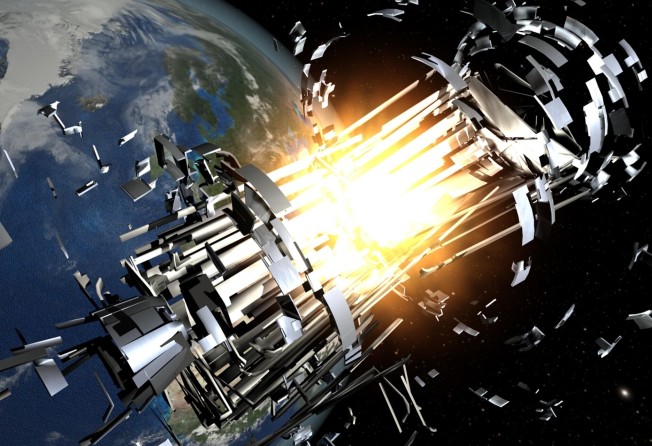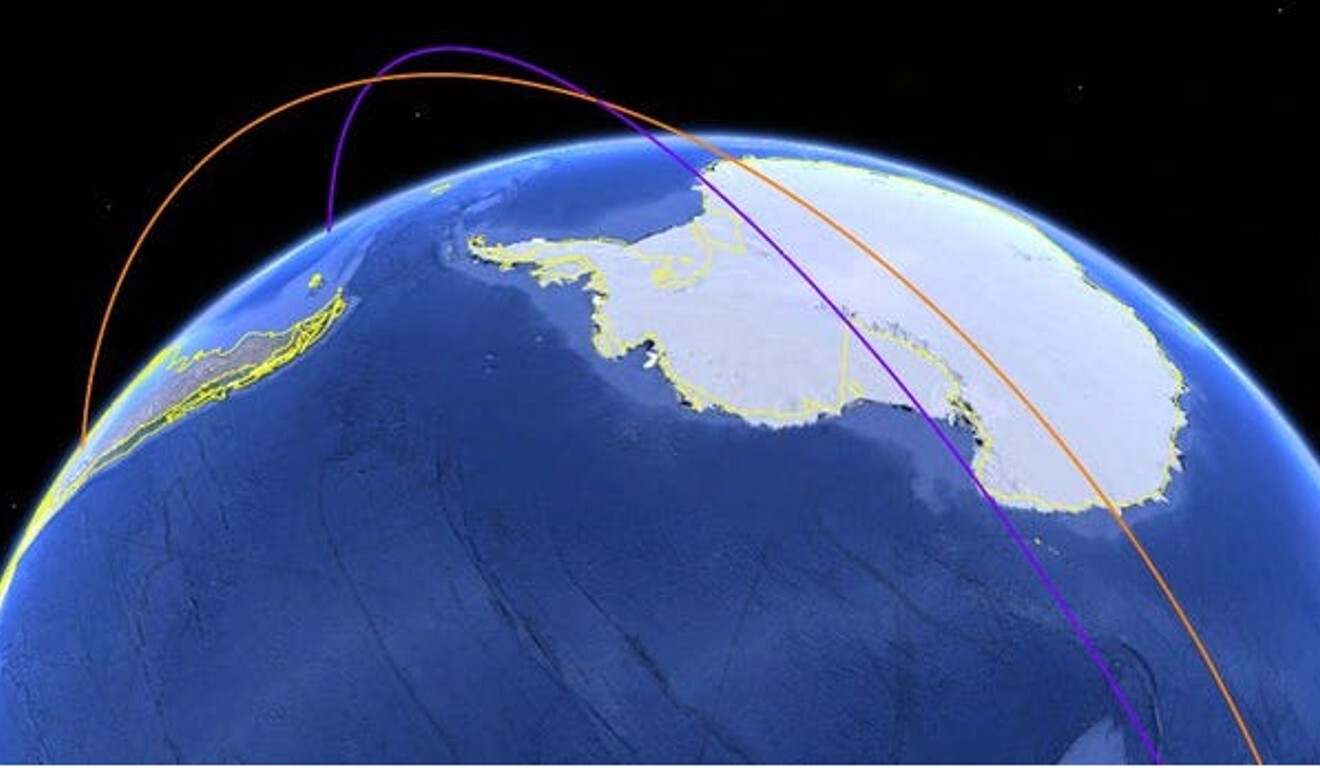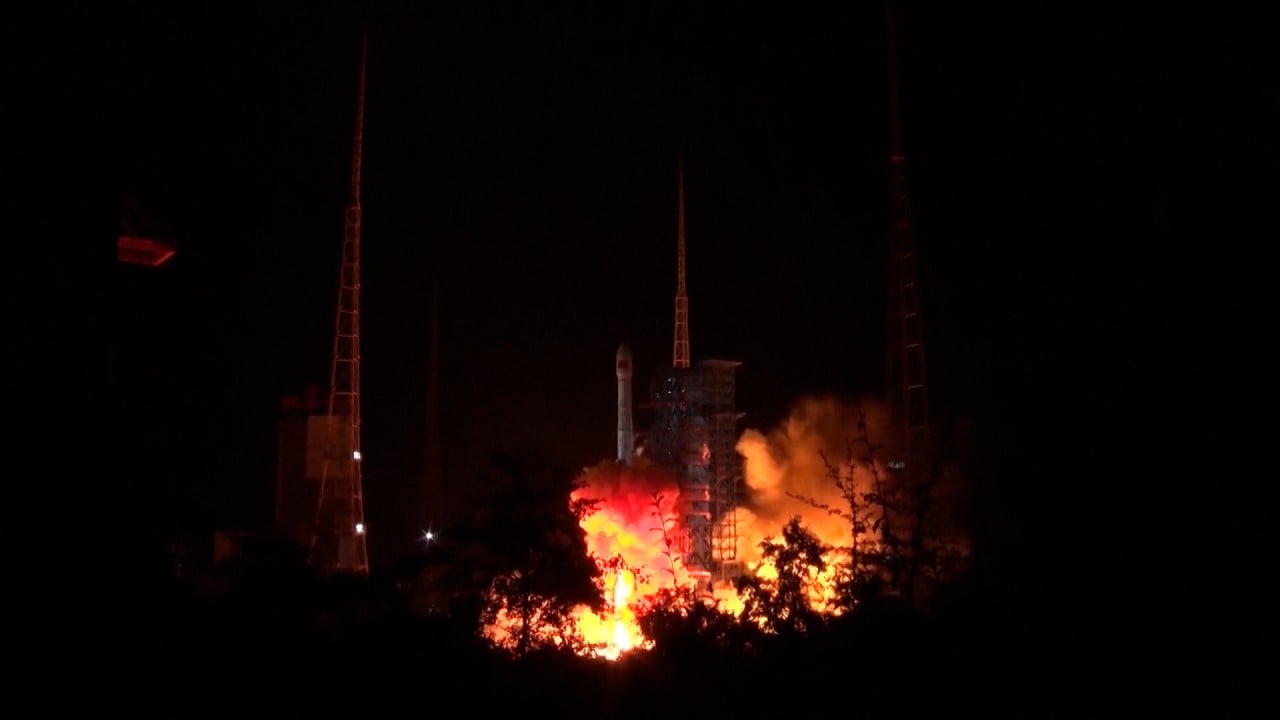1/ This event continues to be very high risk and will likely stay this way through the time of closest approach. Our system generates new conjunction reports 6-8x per day on this event with new observation data each time. pic.twitter.com/d3tRbcV2P0
— LeoLabs, Inc. (@LeoLabs_Space) October 14, 2020
‘Very high risk’ dead Soviet satellite, Chinese rocket body will collide in space
- Satellite-tracking company LeoLabs calculated the objects could collide at 8:56pm Eastern Time on Thursday
- It’s impossible to intervene to prevent a collision, since both objects are dead and can’t be manoeuvred

A dead Soviet satellite and a discarded Chinese rocket body are speeding toward each other in space and could crash catastrophically on Thursday.
LeoLabs, a company that uses radar to track satellites and debris in space, said on Tuesday night that it was monitoring a “very high-risk” conjunction – an intersection in the two objects’ orbits around Earth. A series of observations since Friday have shown that the two large pieces of space junk could miss each other by just 12 metres (39 feet).
That proximity led LeoLabs to calculate a 10 per cent chance that the objects will collide at 8:56pm Eastern Time Thursday (8:56am Friday Hong Kong time). If they do, the explosion would send bits of debris rocketing in all directions.
We are monitoring a very high risk conjunction between two large defunct objects in LEO. Multiple data points show miss distance
Object 1: 19826
Object 2: 36123
TCA: Oct 16 00:56UTC
Event altitude: 991km pic.twitter.com/6yWDx7bziw— LeoLabs, Inc. (@LeoLabs_Space) October 13, 2020
A 10 per cent chance may seem low, but Nasa routinely moves the International Space Station when the orbiting laboratory faces just a 0.001 per cent (1-in-100,000) chance or greater of colliding with an object.
Since the Soviet satellite and Chinese rocket body are both defunct, nobody can move them out of each other’s way. The odds of a crash will likely change as they approach each other, though LeoLabs expects the risk to stay high.
A collision would probably not pose a danger to anybody on Earth, since the satellites are 991km (616 miles) above the ground and are set to cross paths above Antarctica’s Weddell Sea. But the debris the crash would create could cause major problems in space.
“If this turns into a collision, it’s probably thousands to tens of thousands of new pieces of debris that is going to cause a headache for any satellite that’s going out into upper low-Earth orbit, or even beyond,” Dan Ceperley, the CEO of LeoLabs, told Business Insider. “It’s maybe a much bigger problem than a lot of people realise.”

Experts at The Aerospace Corporation ran their own numbers for the two objects on Wednesday and calculated a much lower chance of collision: just 1 in 250,000 million.
“I don’t mean to throw any shade whatsoever on [LeoLabs’] process or their sensors or anything else,” Ted Muelhaupt, who oversees The Aerospace Corporation’s space-debris analysis, told Business Insider. “But the sensors, the data we have access to says we’re pretty confident [the satellites] are not going to hit.”
Roger Thompson, a senior engineering specialist at the corporation, added: “My guess is probably by the end of today or tomorrow morning, our numbers and their numbers will be much closer”.
Nearly 130 million bits of space junk currently surround Earth, from abandoned satellites, spacecraft that broke apart, and other missions. That debris travels at roughly 10 times the speed of a bullet, which is fast enough to inflict disastrous damage to vital equipment, no matter how small the pieces.
Such a hit could kill astronauts on a spacecraft.
Collisions between pieces of space junk make the problem worse since they fragment objects into smaller pieces.
“Each time there’s a big collision, it’s a big change in the LEO [low-Earth orbit] environment,” Ceperley previously told Business Insider.
Two events in 2007 and 2009 increased the amount of large debris in low-Earth orbit by about 70 per cent.

The first was a Chinese test of an anti-satellite missile, in which China blew up one of its own weather satellites. Then two years later, an American spacecraft accidentally collided with a Russian one.
“Because of that, now there’s sort of a debris belt,” Ceperley said.
Combined, the Soviet satellite and the Chinese rocket body have a mass of nearly three metric tonnes (2,800kg). Given their large sizes, Thursday’s conjunction has the potential to create a significant cloud of dangerous debris.
This isn’t the first time LeoLabs has alerted the world to the possibility of a high-risk satellite conjunction. In January, the company calculated a possible collision between a dead space telescope and an old US Air Force satellite.
The objects did not crash, but Ceperley said that because both satellites “were decommissioned, basically nobody was keeping a close eye on them”.

The US Air Force, which tracks satellites for the government, did not notify Nasa about that potential collision, the space agency told Business Insider at the time.
Experts’ warnings about space junk have only grown more urgent since that near miss.
“We are seeing recently a decided uptick in the number of conjunctions,” Dan Oltrogge, an astrodynamicist who researches orbital debris at Analytical Graphics, Inc, told Business Insider.
Oltrogge uses a software system that has been collecting and assessing conjunction data for the last 15 years.
The recent uptick in orbital encounters, he added, “looks to be very well aligned with the new large-constellation spacecraft that have been launched.”
The large constellations he’s referring to are fleets of internet satellites that companies like SpaceX, Amazon, and OneWeb are planning to launch. In total, the companies plan to launch more than 100,000 satellites by the end of the decade. SpaceX has already rocketed nearly 800 new satellites into Earth’s orbit since May 2019.

01:10
China launches more Gaofen satellites to boost national security and technological development
If the space-junk problem were to get extreme, a chain of collisions could spiral out of control and surround Earth in an impassable field of debris. This possibility is known as a Kessler event, after Donald J. Kessler, who worked for Nasa’s Johnson Space Centre and calculated in a 1978 paper that it could take hundreds of years for such debris to clear up enough to make space flight safe again.
“It is a long-term effect that takes place over decades and centuries,” Muelhaupt told Business Insider in January. “Anything that makes a lot of debris is going to increase that risk.”
The sheer number of objects in Earth’s orbit may already be having a Kessler-like effect – a risk that Rocket Lab CEO Peter Beck described last week.
“This has a massive impact on the launch side,” he told CNN Business, adding that rockets “have to try and weave their way up in between these [satellite] constellations”.
Read Business Insider’s story.